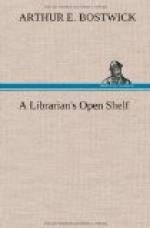How far our certainty as to this is influenced by our ideas regarding the ultimate constitution of the water is worthy of investigation. All who accept the molecular theory, for instance, will regard our inability to trace the elements of a mixture as due to purely physical limitations. A set of Maxwell’s “demons” if bidden to watch the molecules of the water in pail A, one demon being assigned to each molecule, would be able to tell us at any time the precise proportions of any given part of the mixture. But if we should not accept the molecular theory and believe for instance, that water is a continuum, absolutely homogeneous, no matter how small portions of it be selected, then our demons would be as powerless as we ourselves now are to trace the constituents in the mixture.
We are now in a position to ask the question: Is the matter in a mixture of two continua identical with that of its constituents? The identity certainly seems of a different kind or degree from that which obtains in the first case, for there is no part, however small, that was derived from one pail alone. The mixture is something more than a mere juxtaposition of elements each of which has retained its identity; it is now of suck nature that no part of it is identical with any part of A alone or of B alone, nor of A+B, where the sign + denotes simple juxtaposition. It is identical, to be sure, with a perfect mixture of certain parts of A and B, but this is simply saying that it is identical with what it is now, that is, with itself, not with something that went before.
Probably no one now believes that water or any other kind of matter is a continuum, but the bearing of what has been said may be seen when we remember that this is precisely the present stage of our belief regarding energy.
No one, so far as I know, has ventured to suggest what may be termed a molecular theory of energy, a somewhat remarkable fact when we consider the control now exercised over all thought in physics by molecular theories of matter. While we now believe, for instance, that a material body, say a crystal, can by no possibility increase continuously in mass, but must do so step by step, the minimum mass of matter that can be added being the molecule, we believe on the contrary that the energy possessed by the same body can and may increase with absolutely perfect continuity, being hampered by no such restriction.




